The Philippines has a rich history of embracing global influences, and American sports are no exception. From basketball courts in local neighborhoods to football fields in schools, these games have become a significant part of Filipino culture. The introduction of these activities dates back to the late 1800s, following the Spanish-American War, and has since evolved into a national passion.
Basketball, in particular, holds a special place in the hearts of Filipinos. The Philippine Basketball Association (PBA), established in 1975, is the oldest league in Asia and continues to thrive today. Similarly, football has gained traction, with the Philippines Football League showcasing local talent. These games are more than just physical contests; they foster community engagement and national pride.
Understanding the history of these sports in the Philippines provides insight into their cultural significance. From early tournaments to modern leagues, they have shaped the way Filipinos view competition and teamwork. This guide will explore the journey of American sports in the Philippines, highlighting their impact on society and their role in shaping national identity.
Key Takeaways
- American sports like basketball and football have deeply influenced Filipino culture.
- The Philippine Basketball Association (PBA) is the oldest basketball league in Asia.
- Sports foster community engagement and national pride in the Philippines.
- The introduction of these games dates back to the late 1800s.
- Understanding their history provides insight into their cultural significance.
Historical Context of Sports Evolution
From ancient rituals to modern competitions, games have always been a part of human history. Early civilizations transformed simple physical activities into structured events, laying the foundation for today’s contests. These activities were not just for entertainment but also served cultural, religious, and social purposes.
In ancient Greece, the Olympic Games began in 776 BCE as a tribute to the gods. These events included running, wrestling, and chariot racing. Similarly, the Romans celebrated gladiatorial contests and chariot races, drawing massive crowds to venues like the Circus Maximus.
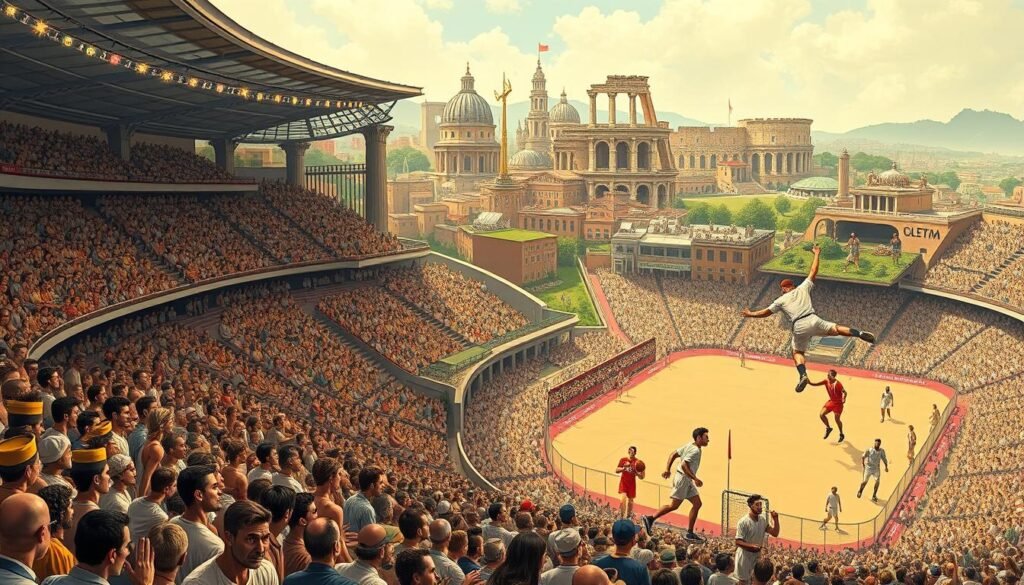
Ancient Egypt also contributed to the evolution of games. Wrestling, archery, and swimming were depicted in tomb paintings dating back to 2400 BCE. These activities were often tied to religious ceremonies and physical fitness.
The transition from spontaneous play to organized matches was driven by community participation and technological advancements. For example, the Mesoamerican ballgame, played as early as 2500 BCE, combined athletic skill with ritual significance.
Here’s a summary of key historical milestones in the evolution of games:
| Period | Event | Significance |
|---|---|---|
| 776 BCE | First Olympic Games | Marked the beginning of organized contests in ancient Greece. |
| 2400 BCE | Egyptian wrestling and archery | Depicted in tomb paintings, highlighting cultural importance. |
| 2500 BCE | Mesoamerican ballgame | Combined athletic skill with ritual significance. |
| 264 BCE | First gladiatorial contests in Rome | Popularized public spectacles in ancient Rome. |
These early forms of games were more than just physical contests. They were gateways to technological and organizational innovations, shaping the way societies viewed competition and teamwork. Today, their legacy continues to influence modern events and leagues worldwide.
The American Influence on Philippine Sports Culture
The American influence on Philippine sports culture is undeniable, shaping traditions and fostering community spirit. During the late 1800s, American colonization introduced games like basketball and football, which quickly became part of local life. These activities were more than just physical contests; they became a way to build connections and pride.
Basketball, in particular, took root in the Philippines. Known as a “Filipino past-time,” it’s played in neighborhoods and schools across the country. The Philippine Basketball Association (PBA), established in 1975, remains a testament to its enduring popularity. Football also gained traction, with local leagues showcasing talent and passion.
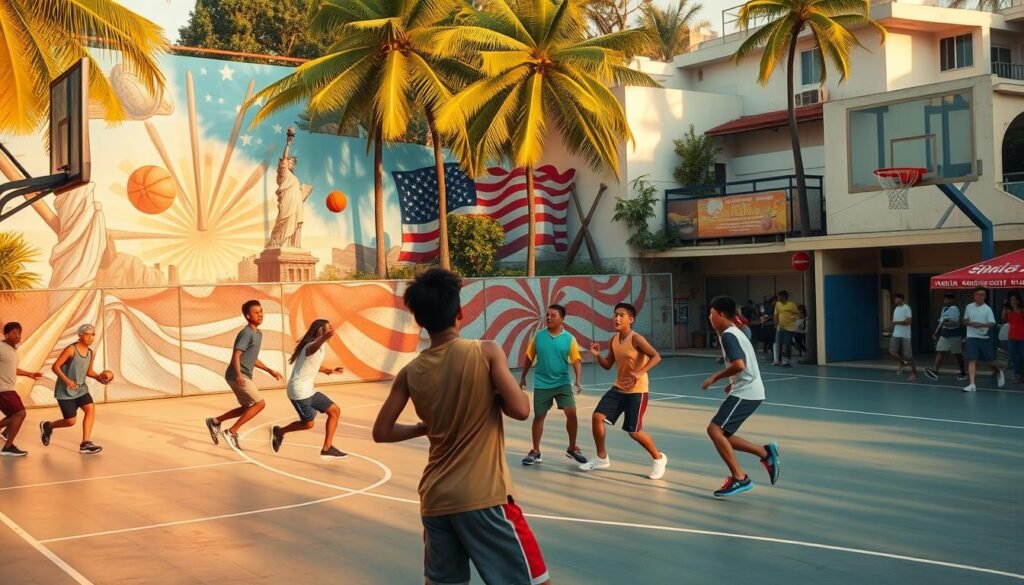
Media played a crucial role in spreading these games. Broadcasting and advertisements brought American sports into Filipino homes, making them accessible to all. This exposure helped create a shared love for these activities, uniting communities across the nation.
American sports also encouraged youth development. Schools and local clubs adopted these games, teaching teamwork and discipline. Events like tournaments became platforms for young players to shine, fostering a sense of achievement and belonging.
The cultural adaptation of American sports is remarkable. Filipinos embraced the rules and strategies while adding their unique flair. This blend of tradition and innovation has created a vibrant sports culture that continues to thrive today.
“Sports have the power to unite people and inspire communities, and the Philippines is a shining example of this.”
From colonial beginnings to modern leagues, American sports have left a lasting legacy in the Philippines. They’ve become more than just games; they’re a way of life that celebrates teamwork, perseverance, and national pride.
Key American Sports and Their Introduction
The introduction of American games to the Philippines marked a turning point in local culture. During the late 1800s, colonization brought activities like football and basketball, which were quickly embraced by Filipinos. These games became more than just physical contests; they symbolized unity and progress.
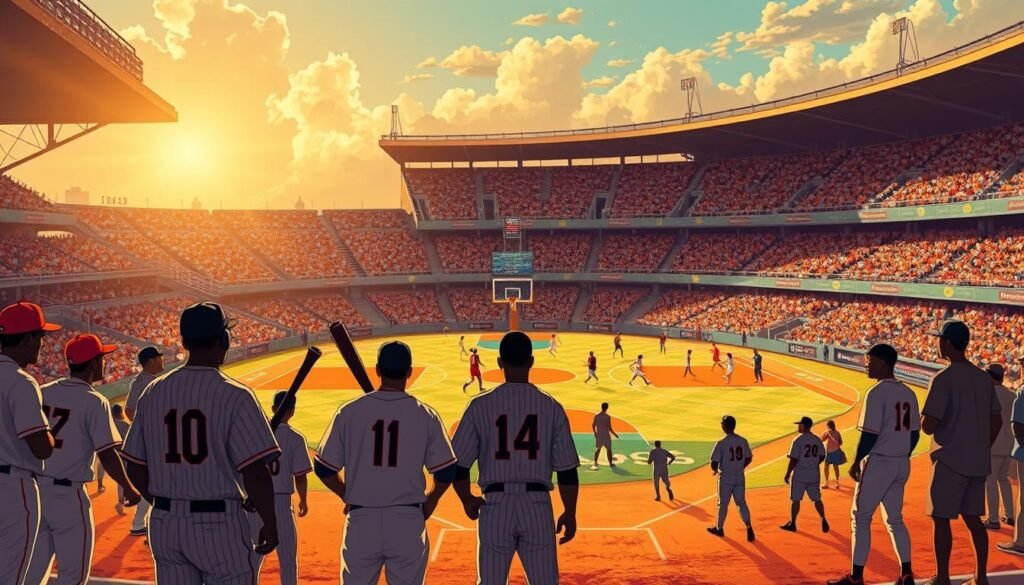
Football and Basketball Adventures
Football and basketball became cornerstones of Filipino life. Basketball, in particular, was adopted with enthusiasm. Neighborhood courts sprang up, and schools incorporated the game into their programs. The Philippine Basketball Association (PBA), founded in 1975, remains a testament to its enduring popularity.
Football also gained traction, with local leagues showcasing talent and passion. The structured format of American football contrasted with traditional Filipino games, offering a new way to compete. Media coverage, including news and video broadcasts, played a key role in spreading these games across the country.
Boxing, Wrestling, and Other Contests
Boxing and wrestling found a unique place in Filipino culture. These combat games were adapted to reflect local traditions, creating a blend of styles. Events like tournaments became platforms for young players to shine, fostering a sense of achievement and belonging.
Here’s a comparison of key American games and their Filipino adaptations:
| Game | American Style | Filipino Adaptation |
|---|---|---|
| Basketball | Structured leagues, professional teams | Neighborhood courts, school programs |
| Football | Organized tournaments, media coverage | Local leagues, community events |
| Boxing | Professional matches, global recognition | Local tournaments, cultural integration |
These games became a way for Filipinos to connect with the world. They fostered community spirit and inspired a new generation of players. From local matches to national leagues, American games left a lasting legacy in the Philippines.
Cultural Exchanges Between America and the Philippines
Cultural exchanges between America and the Philippines have shaped traditions and fostered mutual understanding. These interactions, particularly through games, have created a vibrant blend of influences. From basketball courts to community events, the two nations have shared a dynamic relationship.
American games like basketball and football were introduced to the Philippines during the late 1800s. Filipinos quickly embraced these activities, adapting them to local traditions. For example, neighborhood basketball courts became hubs for community gatherings, blending American rules with Filipino flair.
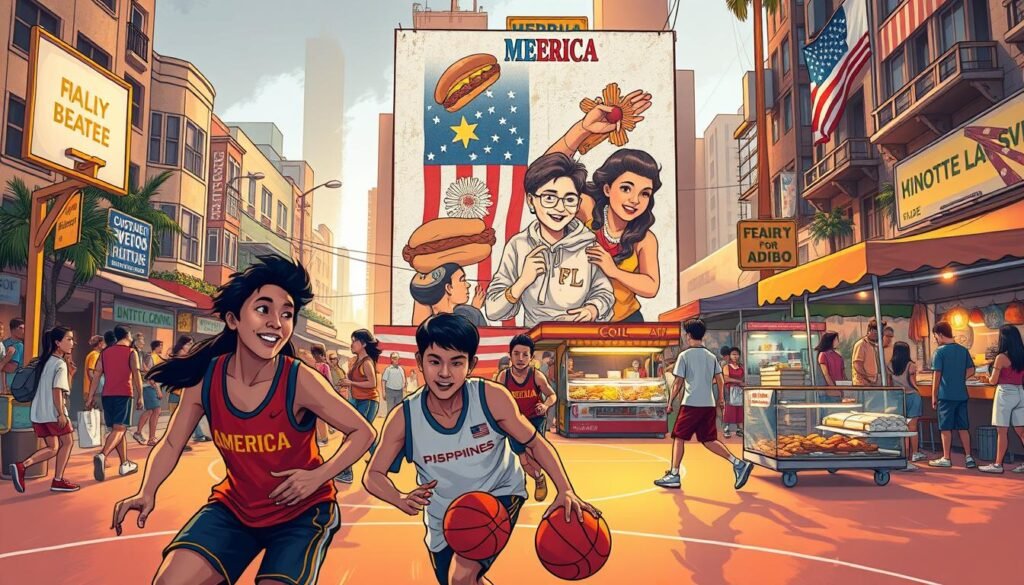
Joint cultural events have further strengthened these ties. Exhibitions and tournaments often feature both American and Filipino teams, showcasing shared values of teamwork and perseverance. These events celebrate diversity while fostering a sense of unity.
Media has played a crucial role in this exchange. Broadcasting and video coverage brought American games into Filipino homes, making them accessible to all. This exposure helped create a shared love for these activities, uniting communities across the nation.
“Cultural exchanges through games have not only entertained but also educated, bringing people closer together.”
Coaching and learning have also benefited from these exchanges. American training techniques were introduced to Filipino coaches, improving local programs. In return, Filipino traditions like community-driven events influenced American practices, creating a two-way street of innovation.
Increased participation in these activities has led to more community celebrations. From local matches to national leagues, games have become a way for Filipinos to connect with the world. These events foster pride and inspire a new generation of players.
Here’s a summary of key cultural exchanges:
- Introduction of basketball and football to the Philippines.
- Joint tournaments and exhibitions celebrating diversity.
- Media’s role in spreading American games across the country.
- Adaptation of American coaching techniques in local programs.
- Community-driven events fostering unity and pride.
These exchanges have left a lasting legacy, shaping the way Filipinos view competition and teamwork. From local courts to international stages, the cultural ties between America and the Philippines continue to thrive.
Impact of Colonization on Local Sports
American colonization brought more than just political changes; it reshaped the Philippines’ approach to physical activities. The introduction of structured games like basketball and football transformed local traditions, blending them with American influences. This integration was not just about physical contests but also about fostering community spirit and national pride.
Educational Integration and Community Engagement
Colonial rule introduced physical education into Filipino schools, emphasizing teamwork and discipline. Games became part of the curriculum, teaching students the value of competition and cooperation. This shift was pivotal in shaping the nation’s approach to sports.
Community engagement also flourished. Neighborhood courts and local leagues became hubs for social interaction. These spaces allowed Filipinos to connect, fostering a sense of belonging and unity. The Philippine Basketball Association (PBA), established in 1975, is a testament to this enduring legacy.
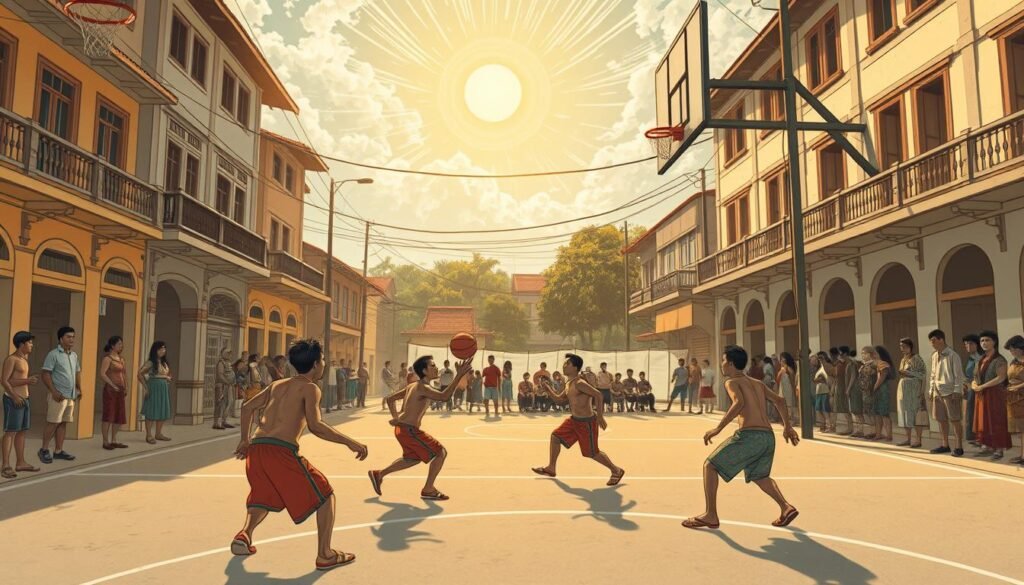
Media Influence and Public Perception
Media played a crucial role in spreading American games across the Philippines. News reports and video broadcasts brought these activities into Filipino homes, making them accessible to all. This exposure helped shape public perception, turning games into a shared national passion.
Televised events like tournaments and matches further solidified this influence. They showcased local talent and inspired a new generation of players. The media’s portrayal of these games highlighted their cultural significance, making them more than just physical contests.
“The integration of American games into Filipino life was a testament to the power of cultural exchange.”
Colonization not only introduced new games but also reshaped the way Filipinos viewed physical activities. From schools to neighborhoods, these games became a way of life, celebrating teamwork, perseverance, and national pride. For more on how cultural exchanges shaped traditions, explore this guide.
Role of Teams, Players, and Leagues
Teams, players, and leagues have played a pivotal role in shaping the landscape of modern games in the Philippines. From local courts to international stages, these elements have fostered talent, inspired communities, and elevated the nation’s profile in the global arena. Their influence extends beyond the game, impacting culture, education, and national pride.
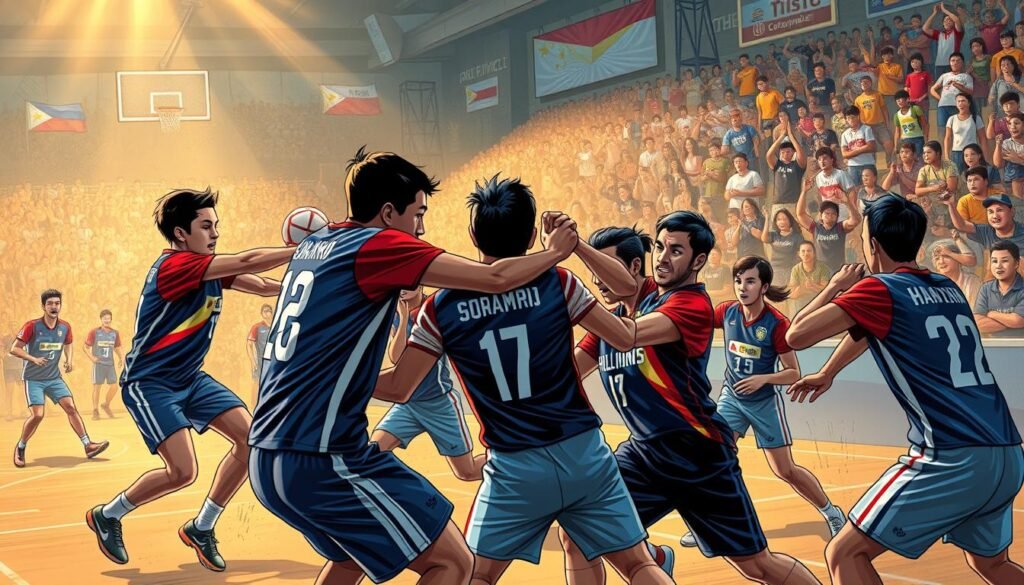
Prominent American Teams
American teams like the Los Angeles Lakers and New England Patriots have set benchmarks in their respective leagues. Their success stories, strategies, and star players have inspired Filipino athletes and fans alike. For instance, the Lakers’ dominance in the NBA has made basketball a household name in the Philippines.
These teams have also influenced local league structures. The Philippine Basketball Association (PBA), for example, adopted formats like playoffs and championships, mirroring American models. This has helped elevate the quality of matches and attract a wider audience.
Filipino Sports Icons Inspired by American Legacy
Filipino athletes like Manny Pacquiao and June Mar Fajardo have drawn inspiration from American legends. Pacquiao’s boxing career, influenced by American training techniques, has made him a global champion. Similarly, Fajardo’s dominance in the PBA reflects the impact of American basketball on local talent.
These icons have not only set records but also inspired the next generation. Their achievements highlight the importance of discipline, teamwork, and perseverance—values deeply rooted in American sports culture.
Here’s a comparison of American and Filipino league structures:
| Aspect | American Leagues | Filipino Leagues |
|---|---|---|
| Format | Playoffs, championships | Adopted playoff systems |
| Media Coverage | Extensive broadcasting | Growing digital presence |
| Youth Development | School programs, scholarships | Local clubs, community events |
The role of teams, players, and leagues continues to evolve, shaping the future of games in the Philippines. Their legacy is a testament to the power of cultural exchange and shared passion for competition.
Evolution of Sports Infrastructure in the Philippines
The Philippines has witnessed a remarkable transformation in its sports infrastructure over the decades. From simple courts to world-class arenas, the development of these facilities has played a key role in shaping the nation’s athletic culture. This evolution reflects a blend of innovation, tradition, and global influence.
Historically, sports facilities in the Philippines were modest, often limited to open fields and makeshift courts. However, the introduction of American standards during the colonial era brought new ideas. Structured venues like gyms and stadiums began to emerge, providing better spaces for training and competition.
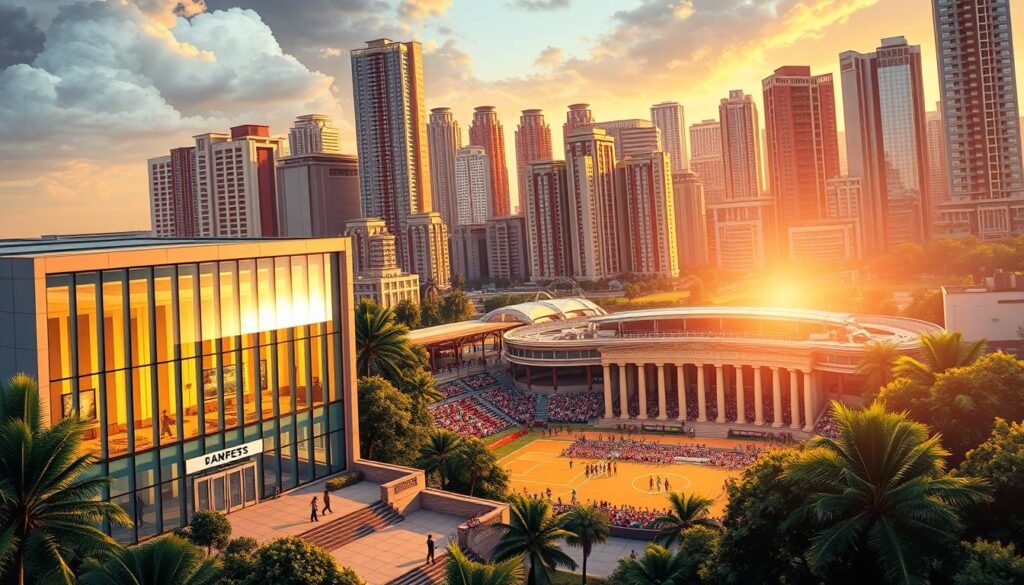
Modern innovations have further elevated the quality of these facilities. Investments in arenas like the New Clark City Sports Complex showcase cutting-edge technology and design. These venues meet international standards, hosting events like the Southeast Asian Games and inspiring local athletes.
Improved infrastructure has led to increased public participation. Accessible gyms, courts, and fields encourage more Filipinos to engage in physical activities. This has fostered a culture of health and teamwork, particularly among the youth.
“Investing in sports facilities is not just about building structures; it’s about creating opportunities for growth and unity.”
Media coverage has documented this growth, highlighting the transformation of sports venues across the country. News reports and video features showcase the impact of these developments, inspiring pride and awareness.
Despite progress, challenges remain. Modernization efforts often face funding and logistical hurdles. However, public-private partnerships have played a crucial role in overcoming these obstacles. Government initiatives, like the Philippine Sports Training Center, aim to bridge gaps and set new benchmarks.
Here are key milestones in the evolution of sports infrastructure:
- Introduction of structured venues during the colonial era.
- Construction of modern complexes like New Clark City.
- Increased public access to gyms and courts.
- Media coverage highlighting venue transformations.
- Government and private investments driving progress.
The evolution of sports infrastructure in the Philippines is a testament to the nation’s commitment to athletic excellence. From local courts to international arenas, these facilities continue to inspire and unite communities.
Adaptation of American Sports Tactics and Training
The adaptation of American training methods in the Philippines has revolutionized local athletic development. From grassroots programs to professional leagues, these techniques have enhanced performance and reshaped the way athletes prepare for competitions. This section explores how coaching innovations and modern training regimens have been integrated into Filipino sports culture.
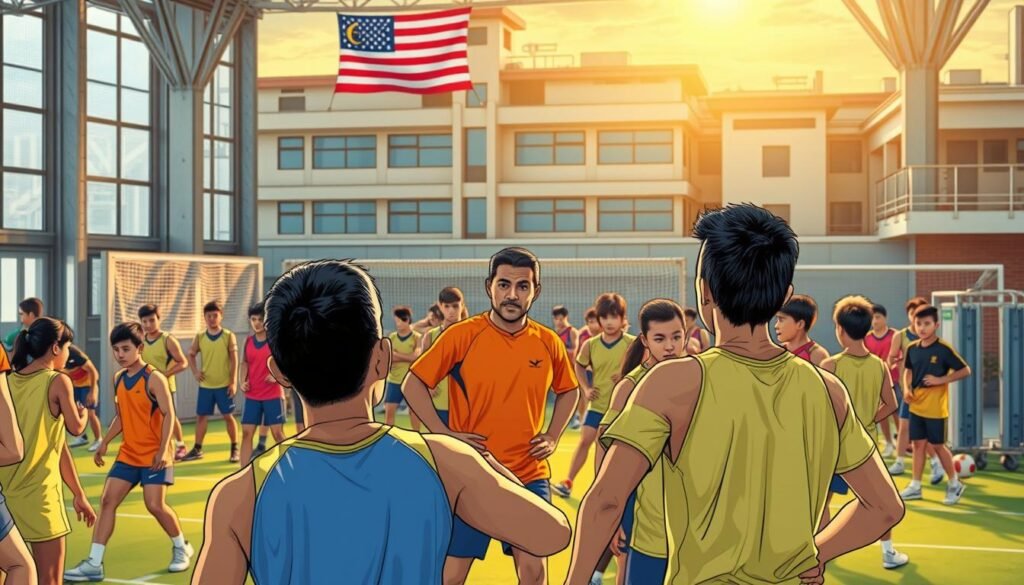
Coaching Innovations
American coaching techniques have been widely adopted in the Philippines, bringing a new level of professionalism to local programs. Coaches now focus on data-driven strategies, using video analysis to study player performance and refine tactics. This approach has been particularly effective in basketball and football, where precision and teamwork are crucial.
One notable innovation is the introduction of sports science into training. Coaches now incorporate biomechanics and nutrition into their programs, ensuring athletes are physically and mentally prepared. This holistic approach has led to significant improvements in performance and injury prevention.
Modern Training Techniques
Modern training regimens in the Philippines blend traditional methods with cutting-edge technology. Athletes now use wearable devices to track metrics like heart rate and speed, providing real-time feedback. This data-driven approach allows for personalized training plans, maximizing efficiency and results.
Another key development is the use of video analysis to study opponents and refine strategies. This technique has been instrumental in preparing teams for high-stakes tournaments. For example, local football teams have used video analysis to study international opponents, gaining a competitive edge.
“The integration of American training methods has not only improved performance but also inspired a new generation of athletes in the Philippines.”
Here’s a comparison of traditional and modern training methods:
- Traditional: Focused on physical endurance and repetition.
- Modern: Incorporates technology, data analysis, and sports science.
These innovations have transformed the way athletes train, compete, and succeed. From local courts to international arenas, the impact of American training tactics continues to shape the future of sports in the Philippines.
Sports Broadcasting and Digital Influence
Streaming platforms have transformed the way fans experience live events. The rise of digital media has brought games closer to audiences, making it easier to follow contests from anywhere in the world. This shift has been driven by innovations in broadcasting, particularly from American media trends.
Rise of Digital Media Coverage
Digital platforms like YouTube, Twitch, and DAZN have revolutionized live coverage. Fans can now watch matches in real-time, interact with other viewers, and access highlights instantly. This has expanded audience reach, especially for events like the Super Bowl and the Olympics.
For example, NBC’s coverage of the 2024 Olympics saw a 497% increase in video views compared to previous years. Their use of generative AI-powered recaps and features like Multiview showcased the potential of modern broadcasting. These innovations have set new standards for how games are consumed.
Impact on Real-Time News and Commentary
Digital media has also changed how news is delivered. Real-time updates and live commentary keep fans informed during crucial moments. Platforms like Twitter and Instagram allow players and teams to share behind-the-scenes content, creating a more personal connection with their audience.
“The integration of digital media has not only enhanced fan engagement but also transformed the way we experience games.”
Local Broadcasters Adopting New Technologies
Filipino broadcasters have embraced these trends, integrating streaming services and social media into their coverage. This has allowed local events, like basketball tournaments, to reach a global audience. The use of video analysis and live streaming has improved the quality of broadcasts, making them more engaging.
Here’s a comparison of traditional and digital broadcasting methods:
- Traditional: Limited to TV and radio, with delayed updates.
- Digital: Real-time streaming, interactive features, and global reach.
The role of social media in sports marketing cannot be overlooked. Hashtags like #SnoopandMartha have created cultural phenomena, driving millions of interactions. This level of engagement has made digital media an essential part of the industry.
As technology continues to evolve, the future of broadcasting looks promising. With over 90 million Americans projected to stream events monthly by 2025, the influence of digital media will only grow. This trend is reshaping the way we watch, discuss, and celebrate games.
Expanding Role of Women in American Sports
The rise of women in American games has reshaped the landscape of competition and representation. From breaking traditional barriers to becoming national icons, female athletes have redefined what it means to excel in the world of games. Their journey is not just about physical contests but also about inspiring the next generation.
Historically, women faced significant limitations in participating in games. However, modern breakthroughs have opened doors for greater inclusion. Events like the Olympics and the FIFA Women’s World Cup have showcased the talent and determination of female players. These contests have become platforms for women to shine on a global stage.
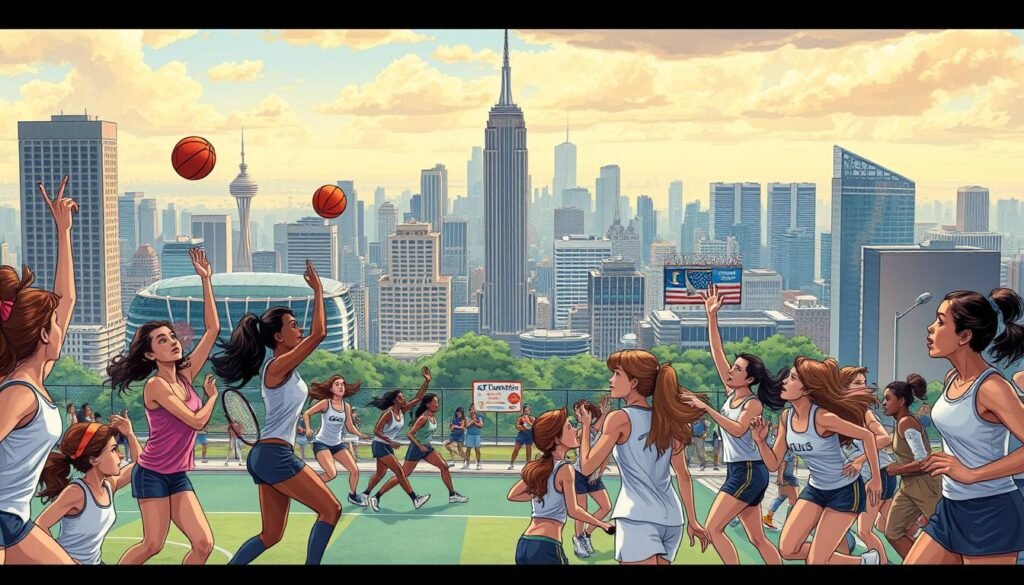
Media representation has played a crucial role in this transformation. While women’s games once received minimal coverage, platforms like ESPN and social media have amplified their visibility. This shift has inspired young women to pursue their athletic dreams, knowing they too can achieve greatness.
“The success of female athletes is not just about winning; it’s about breaking stereotypes and paving the way for future generations.”
Trailblazing women like Serena Williams in tennis and Megan Rapinoe in soccer have become household names. Their achievements highlight the power of perseverance and the importance of equal opportunities. In basketball, the WNBA has provided a platform for women to showcase their skills and compete at the highest level.
This movement has also influenced the Philippines, where women are increasingly participating in games like basketball and volleyball. Local leagues and community events are empowering young women to take part in these activities, fostering a culture of inclusion and pride.
Here’s a comparison of historical and modern participation in women’s games:
- Historical: Limited access, minimal media coverage, societal barriers.
- Modern: Increased opportunities, global recognition, inspiring role models.
The expanding role of women in American games is a testament to their resilience and determination. From local courts to international arenas, they continue to inspire and challenge the status quo, proving that games are for everyone.
Challenges in Integrating American Sports
Integrating American sports into the Philippines faced significant regulatory and cultural challenges. The introduction of these activities required navigating complex frameworks while respecting local traditions. This process was not just about adopting new rules but also about finding a balance between standardization and cultural preservation.
Regulatory and Cultural Hurdles
One of the primary challenges was adapting American sports rules to fit local contexts. For example, basketball and football required modifications to align with existing practices. Regulatory bodies had to ensure that these changes did not dilute the essence of the games while making them accessible to Filipinos.
Cultural resistance also played a significant role. Traditional games like sipa and arnis held deep cultural significance, and their practitioners were wary of being overshadowed by foreign imports. This led to debates about the role of American sports in Filipino society.
Local authorities worked to balance these concerns. They introduced educational programs to explain the benefits of these new activities while highlighting their potential to foster community spirit. This approach helped ease the transition and encouraged broader participation.
Factual Examples and Ongoing Efforts
Disputes over the integration of American sports were not uncommon. For instance, the establishment of the Philippine Basketball Association (PBA) faced opposition from those who feared it would marginalize local games. However, the league’s success eventually won over skeptics, proving that coexistence was possible.
Media coverage also played a crucial role in shaping public perception. News reports and video broadcasts highlighted the positive impact of these sports, showcasing their ability to unite communities. This coverage helped shift attitudes and build support for integration.
“The harmonization of American and Filipino sports traditions is a testament to the power of cultural exchange and mutual respect.”
Today, ongoing efforts continue to bridge the gap between different sports traditions. Programs aimed at youth development and community engagement are fostering a new generation of athletes who appreciate both local and international games. For more insights into the challenges of integrating faith and sports, explore this study.
In conclusion, the integration of American sports into the Philippines was a complex but ultimately rewarding process. By addressing regulatory and cultural hurdles, local authorities have created a vibrant sports culture that celebrates diversity and unity.
The Business of Sports and Economic Impact
The economic influence of games in the Philippines has transformed local industries, creating opportunities for growth and innovation. From sponsorships to advertising, the business side of these activities has become a driving force for development. This section explores how these elements shape the industry and contribute to the nation’s economy.
Sponsorship Trends
Sponsorships have become a cornerstone of the sports industry in the Philippines. Companies invest heavily in teams, leagues, and events to gain visibility and connect with audiences. For example, the Philippine Basketball Association (PBA) attracts major brands, creating a win-win situation for both parties.
International sponsorships also play a significant role. Brands like Nike and Adidas support local athletes, boosting their careers and inspiring the next generation. This trend highlights the global appeal of Filipino talent and the growing importance of sponsorships in the industry.
Advertising and Market Growth
Advertising strategies in the Philippines blend American marketing techniques with local preferences. Brands use social media, TV, and billboards to reach a wide audience. This approach has led to increased market growth, with more companies investing in sports-related campaigns.
Digital platforms like YouTube and Facebook have revolutionized advertising. Live streams and video highlights allow brands to engage with fans in real-time, creating a more interactive experience. This shift has opened new revenue streams and expanded the industry’s reach.
“The integration of sponsorships and advertising has not only boosted the sports industry but also strengthened its economic impact.”
Here’s a comparison of sponsorship trends in the Philippines and the U.S.:
| Aspect | Philippines | United States |
|---|---|---|
| Local Sponsorships | PBA, local leagues | NFL, NBA |
| International Brands | Nike, Adidas | Coca-Cola, Pepsi |
| Digital Advertising | Social media campaigns | Streaming platforms |
The economic impact of major events like the Olympics and FIFA World Cup extends beyond the games themselves. These events boost tourism, hospitality, and retail, creating a ripple effect across industries. For more insights into the economic impact of the sports industry, explore this detailed analysis.
In conclusion, the business of sports in the Philippines is a dynamic and evolving sector. Through sponsorships, advertising, and major events, it continues to drive economic growth and inspire communities. This industry’s potential is limitless, shaping the future of the nation’s economy.
Sports and Education: Bridging Academics and Athletics
Education and athletics have long been intertwined, shaping the lives of students beyond the classroom. Schools across the Philippines are increasingly integrating sports into their curricula, recognizing the dual benefits of physical and mental development. This approach not only enhances academic performance but also fosters essential life skills like teamwork, discipline, and time management.
Development and Scholarship Programs
Scholarship programs inspired by American models are transforming the way students approach education. These initiatives provide opportunities for talented athletes to pursue higher education while excelling in their chosen sports. For example, the Philippine Basketball Association (PBA) collaborates with schools to offer scholarships, ensuring that students can balance academics and athletics.
Such programs are not limited to basketball. Football, volleyball, and other sports also benefit from similar initiatives. These efforts highlight the importance of creating pathways for students to achieve both academic and athletic excellence. As one coach noted,
“Scholarships are more than financial aid; they are a gateway to a brighter future.”
The Dual Benefit of Academic and Athletic Excellence
Engaging in sports can significantly boost students’ self-esteem and overall well-being. Studies show that students who participate in athletic programs are 40% more likely to develop leadership skills. Additionally, the physical activity involved in sports reduces stress and improves sleep quality, contributing to better academic performance.
Collaborations between schools and sports leagues further enhance these benefits. Events like tournaments and school competitions provide platforms for students to showcase their talents. These activities also foster a sense of community and pride, uniting students, teachers, and parents.
Programs like the Faculty Liaison Program at Gustavus Adolphus College demonstrate the positive impact of bridging athletics and academics. By encouraging faculty to engage with student-athletes, these initiatives create a supportive environment that values both academic and athletic pursuits.
In conclusion, the integration of sports into education is more than just a trend; it is a powerful tool for holistic development. From scholarships to community events, these programs are shaping a new generation of well-rounded individuals who excel both on and off the field.
Sports: The American Impact on the Philippines
The fusion of American athletic traditions with Filipino culture has created a unique sporting landscape in the Philippines. From the introduction of basketball and football to the evolution of modern training methods, American influence has left an indelible mark on the nation’s athletic identity.
Basketball, in particular, has become a cornerstone of Filipino life. The Philippine Basketball Association (PBA), established in 1975, remains a testament to its enduring popularity. Neighborhood courts and school programs have made the game accessible to all, fostering a sense of community and national pride.
Football has also gained traction, with local leagues showcasing talent and passion. The structured format of American football contrasted with traditional Filipino games, offering a new way to compete. Media coverage, including news and video broadcasts, played a key role in spreading these games across the country.
Training methods have evolved significantly, blending traditional techniques with modern innovations. Coaches now focus on data-driven strategies, using video analysis to refine tactics. This approach has been particularly effective in basketball and football, where precision and teamwork are crucial.
“The integration of American sports into Filipino life has not only improved performance but also inspired a new generation of athletes.”
Infrastructure development has also been a key factor. From simple courts to world-class arenas, the Philippines has invested in facilities that meet international standards. Venues like the New Clark City Sports Complex host major events, showcasing the nation’s commitment to athletic excellence.
The economic impact of these activities is undeniable. Sponsorships, advertising, and major events like the Olympics have boosted local industries, creating opportunities for growth and innovation. For more insights into how Filipino athletes are building on their historic achievements, explore Filipino athletes’ resilience and potential.
In conclusion, the American impact on Philippine sports has been transformative. From cultural integration to economic growth, these activities have become a way of life, celebrating teamwork, perseverance, and national pride.
Modern Trends in American Sports Adoption
The integration of cutting-edge technology and innovative training methods is reshaping how American sports are adopted in the Philippines. From advanced analytics to wearable devices, these trends are enhancing both athlete performance and fan engagement. This evolution is not just about adopting new tools but also about creating a more immersive and data-driven experience.
Digital Tools and Streaming Media
Digital platforms like YouTube and Twitch have revolutionized how fans consume sports. Live streaming and interactive features allow viewers to watch matches in real-time, fostering a deeper connection with their favorite teams. For example, the Super Bowl saw a 497% increase in video views due to innovative broadcasting techniques.
In the Philippines, local broadcasters are adopting these trends. Streaming services and social media are making events like basketball tournaments accessible to a global audience. This shift has not only expanded viewership but also created new revenue streams for the industry.
Innovative Training Programs
Training methods have evolved significantly, blending traditional techniques with modern technology. Wearable devices now track metrics like heart rate and speed, providing real-time feedback to athletes. This data-driven approach allows for personalized training plans, maximizing efficiency and results.
AI-powered tools are also making waves. Platforms like PlaySight use optical sensors to analyze player movements, offering insights that were once impossible to gather. These innovations are helping Filipino athletes compete at higher levels, both locally and internationally.
“The future of sports lies in the seamless integration of technology and tradition, creating opportunities for growth and excellence.”
Future Outlook and Challenges
Looking ahead, the adoption of AI and machine learning is expected to drive further innovation. Predictive analytics will help teams adjust strategies in real-time, while virtual reality could revolutionize training programs. However, challenges like funding and accessibility remain, particularly in rural areas.
Despite these hurdles, the potential for growth is immense. As technology continues to evolve, it will play a pivotal role in shaping the future of sports in the Philippines. From grassroots programs to professional leagues, these advancements are paving the way for a new era of athletic excellence.
Conclusion
The journey of American games in the Philippines reflects a blend of tradition and innovation, shaping a vibrant athletic culture. From the introduction of basketball and football to the evolution of modern training methods, these activities have become a cornerstone of Filipino life. The Philippine Basketball Association (PBA) stands as a testament to this enduring legacy, fostering community spirit and national pride.
Historical contexts merge with modern trends, creating a dynamic landscape. Media and technology have played crucial roles in spreading these games, making them accessible to all. Events like the Olympics and local tournaments have showcased Filipino talent on global stages, inspiring the next generation of players.
The economic impact is undeniable, with sponsorships and advertising driving growth. Infrastructure developments, such as the New Clark City Sports Complex, highlight the nation’s commitment to athletic excellence. These advancements not only enhance performance but also unite communities.
Looking ahead, the integration of AI and digital tools promises further innovation. As technology evolves, it will continue to shape the future of games in the Philippines. For more insights into the long-term effects of athletic training, explore this comprehensive study.
In conclusion, the legacy of American games in the Philippines is a testament to cultural exchange and mutual respect. From local courts to international arenas, these activities celebrate teamwork, perseverance, and national pride, paving the way for a brighter future.
FAQ
How did American sports first come to the Philippines?
American sports were introduced during the early 20th century, primarily through educational institutions and military influence. Schools played a key role in teaching games like basketball and football, which quickly gained popularity.
What role did basketball play in shaping Philippine sports culture?
Basketball became a national obsession due to its accessibility and simplicity. It was embraced by communities across the country, leading to the formation of local leagues and inspiring many Filipino athletes.
How did boxing and wrestling gain traction in the Philippines?
Boxing and wrestling were introduced as part of American entertainment and combat sports. Filipino fighters like Manny Pacquiao later elevated boxing to global prominence, making it a significant part of the nation’s identity.
What impact did American colonization have on local sports?
American colonization brought structured sports programs into schools, fostering community engagement and integrating athletics into education. This helped shape a modern sports culture in the Philippines.
How has media influenced the adoption of American sports?
Media, especially television and digital platforms, has played a crucial role in popularizing American sports. Live broadcasts of events like the NBA and Super Bowl have made these games widely accessible.
Who are some Filipino sports icons inspired by American sports?
Athletes like Manny Pacquiao in boxing and Jordan Clarkson in basketball have become global stars, showcasing the influence of American sports on Filipino talent.
What challenges exist in integrating American sports into Philippine culture?
Cultural differences and regulatory hurdles, such as funding and infrastructure, have posed challenges. However, these are gradually being addressed through partnerships and investments.
How has sports infrastructure evolved in the Philippines?
Over the years, the Philippines has developed modern facilities, including stadiums and training centers, to support the growth of American sports and nurture local talent.
What role do women play in American sports in the Philippines?
Women are increasingly participating in sports like basketball and volleyball, breaking barriers and inspiring the next generation of female athletes.
How does sports education bridge academics and athletics?
Sports programs in schools and universities provide scholarships and development opportunities, helping students balance academics with athletic pursuits.
What is the future outlook for American sports in the Philippines?
With growing interest and innovations in training and media coverage, American sports are expected to continue thriving, shaping the future of Philippine athletics.
Source Links
- Sports in the Philippines
- Philippines – Sports, Recreation, Culture | Britannica
- ‘This Is My Life!’ Why the Philippines Is a Hoops Haven. (Published 2019)
- History of sport
- The History of Sports
- Sports | Definition, History, Examples, & Facts | Britannica
- Filipino Americans and sports
- Philippines – US Influence, Colonialism, Revolution | Britannica
- Sports in the United States
- History of sports in the United States
- Thematic
- Philippines – Culture, Diversity, Traditions | Britannica
- Settler Colonialism is Alive and Well… in Sport?
- Saying Goodbye to Native American Mascots – Global Sport Matters
- Colonization
- Sports league
- Football (soccer) | History, Game, Rules, & Significant Players | Britannica
- The Future of Philippine Sports: Challenges and Opportunities – Pinas Culture
- The Importance of Sports Facilities and Infrastructure – Pinas Culture
- Impact of Lower-Volume Training on Physical Fitness Adaptations in Team Sports Players: A Systematic Review and Meta-analysis – Sports Medicine – Open
- Sport-specific training induced adaptations in postural control and their relationship with athletic performance
- The Evolution of Sports Broadcasting ~ Traditional vs Digital
- Streaming the game: How the rise of digital platforms is changing sports consumption
- Exposure to Women’s Sports: Changing Attitudes Toward Female Athletes
- Facts and figures: Women in sport
- 9 Black Athletes Who Integrated Professional Sports | HISTORY
- Breaking the Color Line: 1940 to 1946 | Baseball, the Color Line, and Jackie Robinson | Articles and Essays | By Popular Demand: Jackie Robinson and Other Baseball Highlights, 1860s-1960s | Digital Collections | Library of Congress
- Sports: Business, Integration and Social Change – Americas Quarterly
- The Economic Impact of Sports: Exploring the Financial Benefits
- The Economics of Sports: Behind the Business of Games and Teams
- High School Athletics and Performing Arts Working Together
- Harnessing The Power Of Sports For Global Diplomacy
- Bridging the Gap – How Sports Play a Key Role in American Education – Corvuss American Academy
- Basketball Remains a Huge Part of Philippines Culture
- Why Is Basketball So Popular In The Philippines? Unveiling The Nation’s Hoops Obsession
- 2025 Sports Trends: Redefining Training & Competitive Advantage
- TOP 7 Sports Technology Trends & Innovations to Adopt in 2025
- Sports Apparel Market Share & Trends | Growth Analysis, 2032
- 7 Conclusions and Recommendations | Sports-Related Concussions in Youth: Improving the Science, Changing the Culture
- Conclusions and Recommendations – Sports-Related Concussions in Youth

